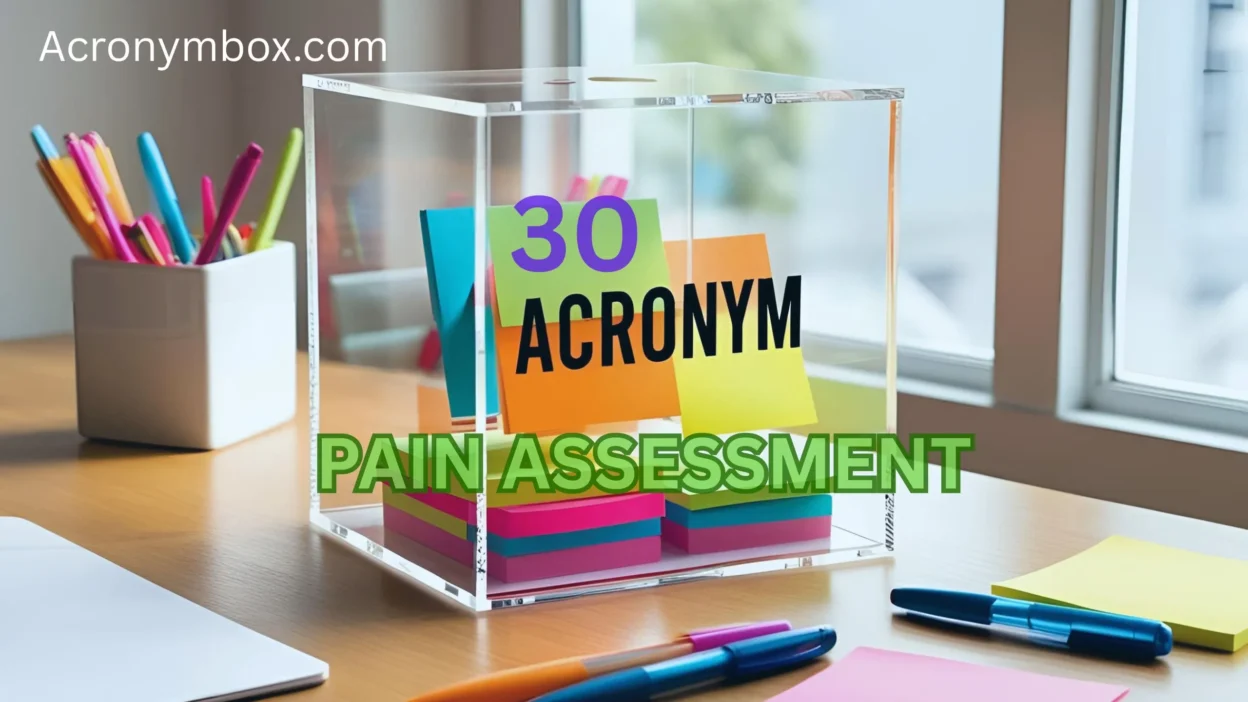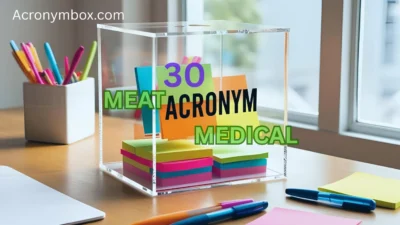When it comes to understanding and treating pain, clear communication is everything. That’s where the term Pain Assessment Acronym comes in.
In medical and caregiving settings, pain isn’t just about intensity—it’s about timing, location, quality, duration, and much more. Using structured acronyms allows professionals to assess pain consistently, thoroughly, and empathetically.
In this article, we’ll unpack the meaning of “Pain Assessment Acronym,” explain why it matters, and provide 30 different acronyms and related tools used in various settings.
Each entry will include a short description, a practical example, and when it’s most appropriate to use—helping you understand subtle differences in tone, application, and patient context.
What Is a Pain Assessment Acronym?
A Pain Assessment Acronym is a mnemonic tool—usually a word formed from the first letters of key assessment elements—designed to help clinicians or caregivers remember how to evaluate pain effectively. It ensures nothing critical is missed during patient evaluation.
These acronyms help guide questions like:
- Where is the pain?
- How intense is it?
- When did it start?
- What makes it better or worse?
Different acronyms are best suited to different situations—some focus on acute pain, others on chronic conditions or pediatric needs.
30 Pain Assessment Acronyms (and When to Use Each)
1. PQRST
- Meaning: Provocation, Quality, Region/Radiation, Severity, Timing
- Example: Using PQRST, the nurse learned the pain radiated to the patient’s left arm.
- Best used: For general pain assessment in adults, especially acute scenarios.
2. OLDCART
- Meaning: Onset, Location, Duration, Characteristics, Aggravating factors, Relieving factors, Treatment
- Example: OLDCART helped determine that the pain worsened after meals.
- Best used: In primary care or emergency settings for comprehensive assessment.
3. OPQRST
- Meaning: Onset, Provocation, Quality, Region/Radiation, Severity, Time
- Example: Paramedics used OPQRST to quickly assess chest pain.
- Best used: For rapid triage, particularly in EMS and trauma.
4. SOCRATES
- Meaning: Site, Onset, Character, Radiation, Associations, Time course, Exacerbating/Relieving factors, Severity
- Example: SOCRATES helped reveal the pain was sharp and came in waves.
- Best used: In clinical or hospital settings for detailed histories.
5. ABCDE (Pain Management)
- Meaning: Ask, Believe, Choose appropriate control, Deliver intervention, Empower patient
- Example: Using ABCDE, the nurse included the patient in choosing a pain relief strategy.
- Best used: For patient-centered pain management and empowerment.
6. COLDSPA
- Meaning: Character, Onset, Location, Duration, Severity, Pattern, Associated factors
- Example: COLDSPA clarified that the pain pattern was cyclical.
- Best used: In nursing assessments and patient interviews.
7. WILDA
- Meaning: Words to describe pain, Intensity, Location, Duration, Aggravating/Alleviating factors
- Example: WILDA revealed the pain was described as “stabbing.”
- Best used: For verbal, descriptive pain assessments in clinical practice.
8. PAINAD
- Meaning: Pain Assessment in Advanced Dementia
- Example: The PAINAD tool was used to assess discomfort in a nonverbal patient.
- Best used: For nonverbal or cognitively impaired older adults.
9. FLACC
- Meaning: Face, Legs, Activity, Cry, Consolability
- Example: The FLACC scale showed a pain level of 8 in the infant.
- Best used: Pediatric and nonverbal pain assessment.
10. BPS (Behavioral Pain Scale)
- Meaning: Facial expression, Upper limb movement, Compliance with ventilation
- Example: BPS indicated high pain levels despite sedation.
- Best used: In ICU for intubated, sedated patients.
11. CPOT
- Meaning: Critical-Care Pain Observation Tool
- Example: CPOT confirmed discomfort in a patient unable to communicate.
- Best used: In intensive care units for nonverbal patients.
12. NIPS (Neonatal Infant Pain Scale)
- Meaning: Facial expression, Cry, Breathing pattern, Arms, Legs, State of arousal
- Example: NIPS helped monitor post-op pain in a newborn.
- Best used: For assessing pain in newborns.
13. CHEOPS
- Meaning: Children’s Hospital of Eastern Ontario Pain Scale
- Example: CHEOPS was used for a 4-year-old post-surgery.
- Best used: Pediatric postoperative pain.
14. COMFORT Scale
- Meaning: Behavioral and physiological indicators
- Example: The COMFORT scale was used to adjust sedation levels.
- Best used: ICU and pediatric intensive care settings.
15. Faces Pain Scale – Revised (FPS-R)
- Meaning: Facial images that represent pain levels
- Example: The child pointed to the third face, indicating moderate pain.
- Best used: Children or language/literacy-challenged patients.
16. VAS (Visual Analog Scale)
- Meaning: 0–10 pain rating on a visual line
- Example: The patient marked 6 on the VAS.
- Best used: Quick and subjective pain scoring in adults.
17. NRS (Numeric Rating Scale)
- Meaning: Verbal 0–10 rating
- Example: She rated her pain an 8 on the NRS.
- Best used: When patients can communicate verbally.
18. Verbal Descriptor Scale (VDS)
- Meaning: Uses words like “mild,” “moderate,” “severe”
- Example: The patient described his pain as “severe.”
- Best used: Elderly or low-literacy populations.
19. McGill Pain Questionnaire (MPQ)
- Meaning: Uses descriptive words to quantify pain
- Example: The MPQ revealed the pain was “burning and throbbing.”
- Best used: Research or complex, chronic pain cases.
20. Brief Pain Inventory (BPI)
- Meaning: Measures impact of pain on daily function
- Example: The BPI showed pain interfering with sleep and mobility.
- Best used: Chronic pain and oncology settings.
21. PEG Scale
- Meaning: Pain intensity, Enjoyment of life, General activity
- Example: The PEG scale showed pain impacting daily satisfaction.
- Best used: Quick screening in chronic pain clinics.
22. Numeric Faces Scale
- Meaning: Combines numbers with cartoon faces
- Example: The child pointed to face number 7.
- Best used: Pediatric or low-literacy patients.
23. Abbey Pain Scale
- Meaning: Designed for dementia patients
- Example: The Abbey Scale flagged possible undiagnosed pain.
- Best used: Aged care and palliative settings.
24. Pain Thermometer
- Meaning: Visual scale resembling a thermometer
- Example: The patient indicated “hot” pain in his back.
- Best used: Older adults and non-native speakers.
25. DVPRS (Defense and Veterans Pain Rating Scale)
- Meaning: Combines numeric scale with emotion and function indicators
- Example: The veteran rated his pain an 8 with sadness and low activity.
- Best used: Military and veterans’ health services.
26. REEDA (For postpartum pain)
- Meaning: Redness, Edema, Ecchymosis, Discharge, Approximation
- Example: REEDA helped assess perineal healing pain.
- Best used: Postpartum pain or wound healing assessments.
27. Oucher Scale
- Meaning: Faces + numeric scale for children aged 3–12
- Example: The child picked the fourth photo on the Oucher scale.
- Best used: Pediatric outpatient pain evaluation.
28. MOPS (Modified Objective Pain Score)
- Meaning: Looks at vital signs and patient response
- Example: MOPS indicated moderate distress post-surgery.
- Best used: Postoperative settings, especially for sedation.
29. CRIES Scale
- Meaning: Crying, Requires oxygen, Increased vitals, Expression, Sleeplessness
- Example: The CRIES scale showed distress in a neonate.
- Best used: Neonatal intensive care.
30. TOTS (Toddler Observation Tool for Symptoms)
- Meaning: Tracks behavior in non-verbal toddlers
- Example: TOTS helped identify teething pain in a 2-year-old.
- Best used: Pediatric care in non-verbal toddlers.
How to Choose the Right Pain Assessment Tool
Consider:
- Patient age: Use tools like FLACC, NIPS, or Faces for children.
- Cognitive ability: Choose PAINAD, Abbey Scale, or BPS for dementia or nonverbal patients.
- Pain complexity: Use SOCRATES or MPQ for detailed chronic pain assessments.
- Environment: EMS teams prefer OPQRST, while ICUs rely on CPOT or BPS.
Cultural and Emotional Factors:
- Some patients may underreport pain due to cultural norms—use observational tools.
- Others may need visual tools due to literacy or language barriers—consider FPS-R or Oucher.
Conclusion
Pain is personal—but assessment doesn’t have to be guesswork. Choosing the right Pain Assessment Acronym ensures that no important detail is missed and that the care provided is respectful, accurate, and tailored to the patient.
Use PQRST or OLDCART for general clinical work, FLACC or PAINAD for nonverbal patients, and MPQ or BPI when dealing with chronic, complex cases. With the right acronym, you’re not just gathering data—you’re hearing your patient more clearly.




